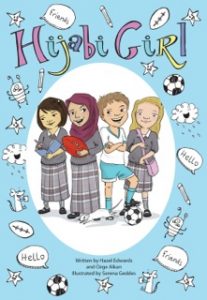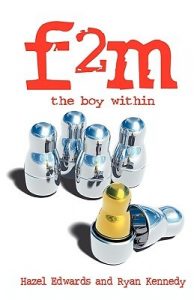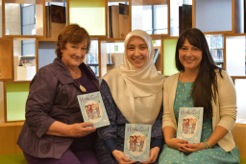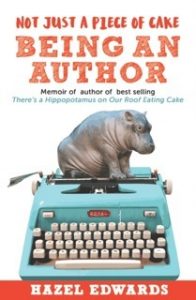Taking Risks with Co-Writing Diversity
My two most ‘risky’ cultural projects have been co-writing ‘f2m: the boy within’, the first Young Adult novel about transitioning gender co-written by an ftm, and ‘Hijabi Girl’ a fun, junior chapter book which had 41 rejections from traditional publishers before I self -published.
I’m not trans and I’m not Muslim. But I do take intellectual and cultural risks as an author.
‘Mentally risky’ means that authors often tackle subjects which can disturb others, by presenting unusual viewpoints, and causing the reader to question their usual attitudes.
 So, sometimes there’s resistance or more requests for clarification. It may even be a new ‘vocabulary’ to explain as well as the concept.
So, sometimes there’s resistance or more requests for clarification. It may even be a new ‘vocabulary’ to explain as well as the concept.
But it can also mean that it takes much energy to initiate a new way of doing things. And so the innovative writer is ‘risking’ because there is a higher likelihood of rejection. Also a loss of income in comparison with writing the ‘expected’ and previously successful.
Anticipatory anxiety that others may not understand.
Or it may be about taking the risk to write accessibly in an area where many may have prejudice due to ignorance or fear.
‘Diversity’ has as many definitions as there are stories. And there’s a growing trend to permit only those who have experienced that culture to write about it.
I disagree.
Respectful research or co-writing are ways of offering insight into that culture for the international reader. And a well known author can take that ‘niche’ story into mainstream readership.
It’s not propaganda. The book is taking the reader into another world for the length of that story, and emerging with a slightly different viewpoint and maybe more tolerance of a minority.
And fiction is often more effective than non-fiction, in starting discussions about controversial issues, but one stage removed from the personal situation in the family.
These are the projects which have given me the most satisfaction. And heart- felt fan mail.
 ‘f2m:the boy within’ has saved lives because it is an accessible book to start parents talking . A fiction book is an easier gift than a list of facts.’
‘f2m:the boy within’ has saved lives because it is an accessible book to start parents talking . A fiction book is an easier gift than a list of facts.’
Authors take different kinds of risks in getting their books out there.
Physical. Cultural. Financial. And mental.
Although I’ve been on an Antarctic expedition, I’m not physically adventurous. I tend to find myself in places which others consider adventurous. Why? I want to understand the motivation which drives physical risk-takers or thrill-seekers so I can write credible characters. And participant-observation is an effective way of writing realistically about leeches, altitude sickness or red sand.
I’m in favour of participant-observation experience for stories which need realistic details like trekking or being on a polar ship beset in Antarctic pack-ice. Antarctica has a mystique, but I’m not a scientist.
Respectful information gathering about a culture for a book is not the same as joining that group. Using an ‘expert’ reader to check facts in a manuscript and a ‘naïve’ reader to check the story is my practice. Whatever the subject.
Excluding those who have not grown up in that Islamic religious or fluid gender culture from writing fiction in that setting is short- sighted. An experienced author who is ‘new’ to a situation asks all the questions others are too nervous to say. Then the writer takes the essence of that and crafts it into a fictional scene with characters with whom the reader can empathise.
Co-writing, as an experienced author, with a new writer who has experienced that culture, is the best way to share those stories widely. And without that ‘lived’ expertise, the writer would have to research for years. So it is genuinely an equal collaboration.
Hence the need for festivals like Midsumma with mainstream writers like me talking on radio about how we co-wrote the Young Adult novel ‘f2m: the boy within’ which is a ‘coming of age’ story with a character Skye who transitioned to Finn. And explaining that my transgender co-author was experienced in the fluid gender culture.

Copyright Hume City Council
Or ‘Hijabi Girl’ which is a humorous junior chapter book with a hero Melek who wears a hijab but is a newcomer girl character with enthusiasm and a sense of humour. My co-author is a Muslim children’s librarian and wears a hijab. I’m agnostic and do not wear a hijab. Character Book Parades are fun customs in mainstream Australian school, but librarians couldn’t find a character in a hijab, with whom some of their young students could identify, so we co-wrote one. Decades earlier I had written ‘Misfit’ about a non-Jewish, hockey-playing girl in a religious Jewish school and the kosher food and cultural challenges. I am not Jewish but my children attended a Jewish school for a time.
Participating on panels about ‘Diversity’ which is defined in as many ways as there are writers and subjects, is also risky. ‘Diversity’ is the ‘in’ term and some people approach their subject with an evangelical zeal bordering on fanaticism. Others just wish to share and to learn.
‘Mentally risky’ is not writing propaganda, which is presenting one side of a political /religious/ gender issue. It is about good writing of universal issues, with compassion and humour.
And then there’s the increasing lobby of critics who claim you cannot write of other cultures because you are not entitled to tell their stories. I disagree. With respect and good research, a writer should be androgynous and able to write from character viewpoints who are not autobiographical. And from different age viewpoints too.
But it is risky.
Co-writing provides authenticity from the ‘expert’ who may be a debut novelist and the opportunity to appeal to an existing mainstream audience who follow the known author.
Our ‘Diversity’ Case Study: The Two of Us
Hazel’s View:
Speaking at a literary event in 2012, I met Ozge as a librarian-educator in the audience. Her enthusiasm and breadth of reading intrigued me. It wasn’t just that she was a fan of the cake-eating hippo books. She convinced me to visit her Islamic school as their first author. I practised saying her name correctly and had it written phonetically on a sticky label on my computer screen.
Unable to fulfill a student’s request for a young girl character in a hijab to dress up for their Book Parade, Ozge asked,
‘Could you write one?’
I suggested she write her own book, as she knew the culture. Plus she was a librarian with zany ideas which she made happen. Turkish born, she spoke with an American accent. I was intrigued by how many hijabs she possessed. ‘Multiples, just like your scarves!’ she teased me.
We kept in contact. Extremely hospitable, Ozge invited my family to the Street Iftar during Ramadan. Her husband Ahmet showed the males in our family over the Mosque. We went to a special exhibition at the Immigration Museum. Ozge explained customs and the concept of modest clothing that didn’t cling.
It’s hard to say ‘no’ to Ozge so I agreed to co-write. After 41 rejections of our proposal, I decided to self publish.
Our families have become friendly. At one celebration, I had to cater for hallal, kosher, allergies, gluten-free and no dairy.
When Ozge’s baby daughter was born, my daughter Kim and I visited.
I’m agnostic, but I respect others’ beliefs.
Ozge has introduced me to Islamic traditions. I do not think women should all wear hijabs. But I believe in readers entering other worlds via a book and maybe behaving with more understanding and tolerance, after they have closed the book. I can pronounce Ozge now, but suggested she shorten her author surname to Alkan so we could all fit on the front cover. This is Ozge’s first book and my 201st.
Illustrator Serena Geddes and I have learnt about making illustrations culturally appropriate and lengthening sleeves and skirts. And I’ve learnt about food and hijabs and Aussie Rules football.
Our fiction predictions are coming true. Now there is a Hijabi Barbi and footy club colour-coded hijabs for fashionistas. Footy fan Ozge wears a red and black hijab in the footy season.
Sometimes a funny book can make a serious difference.
****************************************************
Ozge Alkan’s View
Hazel’s ‘f2m; the boy within’ young adult novel caught my eye when I was completing my work placement at Melbourne Library service as part of my Master of Information studies degree. I only knew of Hazel as a children’s author and I was surprised to see that Hazel wrote a YA book on such a challenging subject.
A few days later, I met Hazel at a professional development event for Teacher Librarians. I struck up a conversation with her about F2M after the event and we spent the next hour chatting about authorship, diversity, libraries and everything in between. At that time I was working as a school librarian at an Islamic College and I invited Hazel to visit our students for the book week.
I organised a character parade for the students every book week. A hijab was part of the uniform for all female students in grade three and up. This meant any character the student found to dress up at the character parade had to be modified into a hijabi character. I always wanted a book with a hijab wearing vivacious young girl as the main character to hand to my students.
When Hazel visited our school I asked her if she would write such a book. I am sure as an author they often hear ideas for books from other people but Hazel found the idea intriguing. After many e-mails back and forth we decided to tackle the project together. Three years after our initial meeting ‘Hijabi Girl’ was finally born. Our book baby.
Between all the emails, excursions to the Islamic events and Skype chats, I became friends with Hazel and her family. She was one of the earliest people I told about my pregnancy and she decided publication of ‘Hijabi Girl ‘was going to be her gift to my baby. Luckily she also gifted us an autographed copy of ‘There’s a Hippopotamus on Our Roof Eating Cake’, my daughter isn’t old enough to enjoy ‘Hijabi Girl’ yet.
—
 Hazel Edwards OAM is the author of ‘There’s a Hippopotamus on our Roof Eating Cake’. Her ‘Writing a Non Boring Family History’ workshops are popular with ‘genis’ families. Her ‘Authorpreneurship: The Business of Creativity’ was published by ASA’s Keesing Press in 2012. Not Just a Piece of Cake; Being an Author (Brolga) was released in November, 2015.
Hazel Edwards OAM is the author of ‘There’s a Hippopotamus on our Roof Eating Cake’. Her ‘Writing a Non Boring Family History’ workshops are popular with ‘genis’ families. Her ‘Authorpreneurship: The Business of Creativity’ was published by ASA’s Keesing Press in 2012. Not Just a Piece of Cake; Being an Author (Brolga) was released in November, 2015.
Find out more about Hazel on her website http://hazeledwards.com/
Hijabi Girl was co-written by Hazel Edwards & Ozge Alkan & illustrated by Serena Geddes.
Misfit is available on Kindle.
Category: Contemporary Women Writers, On Writing
Comments (10)
Trackback URL | Comments RSS Feed
Sites That Link to this Post
- Taking Risks with Co-Writing Diversity | WordHarbour | June 15, 2016


























A update on the books mentioned in the article written 5 years ago. ‘Hijabi Girl’ has a sequel co-written book coming post-Pandemic ‘ Hijabi Girl Plays Footy Too’ and the Larrikin Puppets musical with waiting puppets and audio, is ready to perform Post-Pandemic.
So sometimes it’s important to take a risk and tackle co-writing diverse projects, with respect and persistence.
I have an issue with the word ‘permit’ here – anyone is ‘permitted’ to write anything.
The argument within the Diversity Movement is that perhaps not everyone *should* write anything they want – i.e., if people don’t write with enough understanding of the marginalisation they are writing about, or take the place of #OwnVoices books within a publisher’s upcoming releases or marketing resources, etc.
I think that co-writing in particular is a good way of making sure this is covered, but the issues within publishing remain.
Dear Cee,
Your comments are valid. I tend to agree about the need to research carefully when you are writing of a culture other than your own. But co-writing is a feasible option so stories reach mainstream audiences too. I’m delighted that our ‘f2m:the boy within’ has now been optioned for new media, and the writer will be from within the trans community collaborating with Ryan who is trans. If our original , co-written novel hadn’t existed, (one trans co-author and myself) this couldn’t have happened.
As I said, co-writing is a good way of covering topics both authentically and sensitively. Though this doesn’t free anyone from potential criticism, of course, but does make it less likely they’ll do something that people wish to criticise.
My point was that no-one is restricting non-marginalised creators. No-one is controlling what they can or cannot write. But often, and often unintentionally, non-marginalised authors take resources and shelf-space that marginalised authors already have to fight for – which is why it’s so important that marginalised voices are boosted as much as possible.
The way to improve diversity (which I hesitate to mention is generally less complicated to define than you imply,) within books and publishing is by adding more chairs to the table, instead of removing seats that could be taken by marginalised creators.
And it is of course true that if your book hadn’t been written then it couldn’t be adapted. It’s excellent news that the writer will be transgender.
I’d like to report to booksbywomen that 2 years after writing about self-publishing ‘HIjabi Girl’ ,it has now had a fifth ( small) reprint with Bookpod, we’ve spoken on ‘diversity’ panels, audio recorded ‘Hijabi Girl’ for Vision Australia blind students and signed an option for other mediums. And during the recent Children’s Book Week, we had readers choosing to dress as our Melek character for Book Parades in mainstream schools. And as a compliment ‘Breakfast of Literary Stars’ in Sydney created a Melek character in a hijab as the table decoration for our Star illustrator Serena Geddes. Sometimes it’s worthwhile accepting the challenge to write… http://www.hazeledwards.com
Thank you Jyotsna, With ‘Hijabi Girl’ now published we’re finding our collaboration even more mutually supportive, as we each speak to different groups. Serena has many illustrative and animation colleagues while Ozge’s cultural contacts have been thrilled by the existence of a mainstream children’s story which is fun, and the hero wears a hijab. The existence of the free, downloadable classroom play script which can be used in Book Week, has meant easy access for mainstream classrooms. We’ve even been asked for sequels.
Hooray for diversity! Co-writing seems like a good way to go about it.
Thankyou Jyotsna, I agree that co-writing across cultures is the best way to have quality writing but also to save time because the co-writer has already researched the culture via experience. And if the co-writer is a first-time author, it gives them significant publishing experience and maybe the opportunity to write more. Plus the content is authentic. Our ‘f2m:the boy within’ has been more widely read in mainstream because of the co-authorship. And ‘Hijabi Girl’ lookins liek achieving that too.
I’m all for more diversity in children’s books, and this sounds like a wonderful, cooperative way of going about it!